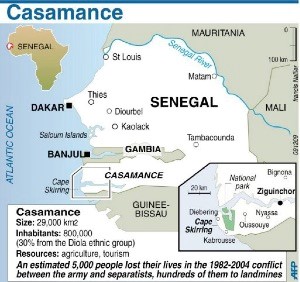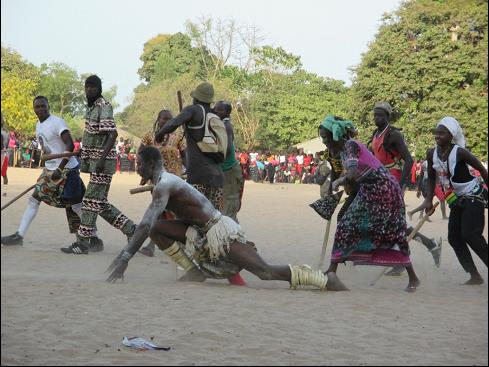The marquee combatants arrived in the late afternoon, welcomed by musical odes and a chorus of erratic drumming. Each defied his massive frame, nimbly performing the “dance of champions” and taking measures to repel black magic before stepping into the ring. The preparations at the stadium for the fight lasted hours; the bout, mere minutes. For the wrestlers and their fans, however, the outcome would endure for years. (Nicholas Loomis, The New York Times, 2012, p. B9)
Thus went one journalist’s description of the stakes and the passion surrounding the 2012 match between challenger Balla Gaye 2 and Yahya Diop, also known as “Yékini,” the reigning Senegalese “traditional” wrestling champion.1 After hours of preparation, the relatively short match resulted in Balla Gaye 2 (his wrestling “stage name” … his birth name was Omar Sakho) being crowned the new champion. Sakho, whose family comes from the Casamance - the southern Senegalese region geographically separated from the rest of the country by The Gambia - personified the contested identities of the wrestling stadium in Senegal. Simultaneously Casamançais and Senegalese, Sakho has excelled at the Senegalese national pastime. These identities have been contested in other Senegalese spaces as well, including the battlefields of the Lower Casamance region, where separatist guerilla fighters since 1982 have sporadically fought Senegalese forces for the independence of the Casamance. It may seem like a stretch to tie the “combat” in the wrestling stadium to that of the battlefield in the Casamance. After all, wrestling has played a more integrative role than soccer, especially considering the ties in the early 1980s between the soccer club Casa-Sports and the separatists (Deets, 2016). Nevertheless, many Casamançais claim that their wrestling is different from that of northern Senegal. They have tied ideas of “purity” to Casamançais wrestling against what they call the “trickery” of Senegalese wrestling (Ansoumana Abba Bodian, individual statement, 19 April 2014; Bertrand Diamacoune, individual statement, 4 April 2014; representatives from Bignona Chapter of MFDC, group statement, 24 April 2014; senior MFDC official, individual statement, 25 April 2014). They have posited their wrestling as one more cultural marker of “difference” from Senegal.
These feelings of difference have been one ingredient in the mix of factors that led to the Casamance conflict. After a meeting near Diabir - a village on the southwestern edge of Ziguinchor - on Christmas Night, 1982, hundreds of separatists from the Casamance marched into town the next morning, following a group of women pouring cool water on the ground to symbolize their “peaceful” intentions (Marut, 2010, p. 100).2 The separatists claimed to have revived a 1950s regional political party known as the Mouvement des Forces Démocratiques de la Casamance (MFDC).3 They marched to the Governor’s Office, lowered the Senegalese flag flying in front of the building, and ran up a white flag (“Une manifestation insurrectionnelle”, 29 December 1982). Senegalese gendarmes and police responded by beating marchers with billy clubs and occasionally firing their weapons above the marchers’ heads (Ansoumana Abba Bodian, individual statement, 19 April 2014).4 In the melee that followed, the enraged crowd killed two gendarmes (Diatta, 2017, p. 62). No separatists were killed that first violent day, but dozens were wounded, bruised, and bloodied. Mass arrests and torture followed (Amnesty International, 1998). When gendarmes in 1983 tried to break up a similar meeting in Diabir near the one-year anniversary of the separatist march, separatists attacked - killing three and wounding four of the gendarmes and then mutilating their corpses (Lacotte, 1983). What followed was over three decades of sporadic, low-intensity conflict that killed more than 5,000 people, displaced 60,000, affected 90,000 by land mines (including about 500 civilians killed or maimed by land mines), and left 800,000 living in a state of insecurity (UN Integrated Regional Information Network (IRIN), 2008; Handicap International, 2006, p. 8; De Jong & Gasser, 2005, p. 213). Now nearly forty years old, the conflict has earned the ignominious title of “Africa’s longest-running civil conflict” (Marut, 2011, p. 363). From where did this violence emerge? After all, before that fateful march in 1982, Senegal had been an independent nation-state - with the Casamance a part of it - for over twenty years.
Various scholars have offered various answers to this question. Some have focused on the mobilization of ethnicity, especially among the Jola, the majority ethnic group of the Lower Casamance (Faye, 1994; Lambert, 1998). Others, noting the leadership of a Catholic priest - in a majority Muslim territory - as the Secretary-General of the MFDC, have refuted or de-emphasized the importance of religious identification to the separatist identity (Foucher, 2003, 2005). Or they have focused on the area’s political economy (Evans, 2003; Foucher, 2007, 2011) while countering the popular notion of the Casamance as the “rice basket of Senegal” (Marut, 2010, p. 51). Or they have cited some version of “the resource curse,” contrasting Casamançais natural resources with those of the dry Sahel of the north (Dramé, 2005).5 These various explanations are important and mostly useful to discussions of peace in the Casamance, which has seen several ceasefires but as of yet no permanent peace accord. Except for the work of political geographer Jean-Claude Marut, however, few have focused on the spatial imaginaries or the “cognitive maps” by which Casamançais inhabited and performed the nation, by which they “counter-mapped” the Casamance against state cartographic practices and representations.6
Thus, I build on the spatial approaches of Marut, Allen Howard, Richard Shain, and the late Christopher Gray to argue that the Casamance conflict emerged from contested spaces where separatists asserted a different cultural identity from that of northern Senegal (Gray, 2002; Howard & Shain, 2005; Marut, 1994, 2010). One of these contested spaces was the wrestling stadium. Indeed, because of the “cultural artefacts” of otherness and belonging that Casamançais asserted in The Stadium, they transformed the stadium from space into place - at least to the separatists.7 As Donal B. Cruise O’Brien noted,
In attempting to assess the precise degree and quality of communal allegiances and antagonisms at a popular level, admittedly a very difficult task for any observer, one is I think well advised to look outside political life, and indeed away from the traditional ethnographic domains of social anthropology (as practised in Senegal). Popular attitudes to sport, and in particular to the most popular sport in Senegal - wrestling - may provide a more relevant measure. Here (very literally) is an arena, not only within which various communal champions display their differential physical prowess, but also…around which variously communal crowds display allegiances of course to their preferred champions but also by extension to the tribe or region which the champion is held to represent. (O’Brien, 1978, p. 185)
For many Casamançais, however, and for many of their fellows from northern Senegal, there was no transformation in the stadium: they remained a component of the Senegalese nation (Le Soleil, 1982). Those who felt and asserted “difference” in The Stadium, nevertheless, made Senegalese wrestling - la lutte, which literally means “the struggle” in French - a terrain of struggle for Senegalese nationalists and Casamançais separatists, among a host of ethnic entrepreneurs.
Grappling with terminology
Before going further, a few definitions are in order. In this article, I define “space” as a three-dimensional domain for human action. I define “place” as space infused with meaning. Thus, place can be thought of as space with history.8 To demonstrate the way that separatists sought to transform space into place in the wrestling stadium, I occasionally capitalize “The Stadium” to indicate times and places where separatists sought to assert a separatist identity through the wrestling stadium. These assertions sought to bring nationalism and separatism into The Stadium of Casamançais wrestling matches, where some spectators and participants felt especially “Casamançais.” Some felt “Senegalese” while yet others felt more “Jola” or “Mandinka” or “Serer,” etc. And some felt that nationalism had nothing to do with wrestling.
This is not to say that the Casamançais wrestling stadium became “The Stadium” in a linear, irreversible, monolithic fashion where every person asserted a separatist identity. The spatial assertions of the separatists could only go so far because sports stadiums are always spaces of diverse people and identities - regardless of how much the home team tries to foster a unified team identity to gain a “home field advantage.” Certainly, there were stadiums where nationalism and separatism made little or no appearance - where various identities co-existed at the same time, in the same space. Thus, in this text, when “the stadium” is not capitalized, it is “a stadium,” like any other and relatively devoid of nationalist sentiment.
While some Casamançais separatists may have tried to convert these spaces into places of separatist discontent, they succeeded only sparingly and intermittently. But these few successes were enough to make The Stadium a contested terrain for the cultural identity of the nation.
Soccer and separatism
It is easier to link soccer to separatism in the Casamance (Deets, 2016, 2017). Violence broke out after the final match of the 1980 Senegalese Cup between Casa-Sports and Jeanne d’Arc, a club from Dakar, after a highly disputed referee’s decision. This soccer violence became the final drop that sent the fluid over the edge in the Casamançais “ras-le-bol” experience with Senegal.9 Thus, by the time of the 1982 march into Ziguinchor, separatist tension had been boiling for years.
The soccer stadium became an important space for separatist activity. Separatists held meetings in conjunction with Casa-Sports club meetings at Néma Stadium in Ziguinchor and in Robert Delmas Stadium in Dakar. At Casa-Sports matches, Casamançais distinguished themselves from the Muslim teetotalers of northern Senegal by dressing in palm wine tapping costumes (Foucher, 2002, p. 250).10 Separatists went to the games to distribute copies of Kelumak, a magazine featuring a discourse of Casamançais grievance against the Senegalese state.11 The Casa-Sports section of the stadium became known as “la tribune Katanga,” in reference to the separatist region of the Congo in the 1960s (Diop, 2012, p. 30). Some of the more militant Casa-Sports fans began to refer to their club as not only their regional but as their “national” team as well (Bignona Chapter of the MFDC, 2014). They claimed that the tension at Casa-Sports matches demonstrated that the Casamance was not really a part of Senegal, and they began to attend matches with concealed weapons like billy clubs and machetes (Senior MFDC official, 2014; former Casa-Sports official, 2014).
But very little of this kind of overt separatist activity was prevalent at Senegalese wrestling matches. Most Casamançais supported Casamançais wrestlers, but there were no direct ties between Casamançais wrestlers and separatist cells. Yet, as noted earlier, many separatists or separatist supporters have maintained that the wrestling arena is a place of cultural difference between Casamançais and Senegalese identities (Ansoumana Abba Bodian, individual statement, 19 April 2014; Bertrand Diamacoune, individual statement, 4 April 2014; representatives from Bignona Chapter of MFDC, group statement, 24 April 2014; senior MFDC official, individual statement, 25 April 2014). Why?
“Traditional” wrestling in the colonial stadium
If there were an indigenous “national” sport in Senegal, it was wrestling, not soccer. (I place “national” in quotes here because there was no such thing as Senegal or the Casamance before colonialism.) Soccer only arrived with colonialism. But people in what is now Senegal, as in other cultures around the world, had been wrestling for centuries to note stages of the agricultural cycle and gender rites of passage. They often held matches to mark the end of the harvest season (especially rice and groundnuts) and male and female circumcision and initiation (Faye, 2002, pp. 311-312). Occasionally, fishermen and farmers with fish and crops to spare would wager them on the outcome of a friendly village match (Loomis, 2012, p. B9). The contemporary form of “traditional” wrestling, laamb, seen in wrestling arenas around Dakar, began as a form of freestyle wrestling (la lutte libre in French sources) known as “mbapat” among the Lebu ethnic group, the indigenous people of the Cap-Vert Peninsula. It typically involved “taking down” one’s opponent (terrasser in French), so that his head, back, or both hands and knees touched the ground (Faye, 1984; Faye, 2002, p. 312; Loomis, 2012).
As the sport migrated from the village to the city, it began to change. And these changes took time. During the colonial period, ethnic groups often established their own wrestling arenas, occasionally modifying the rules as needed to wrestle against other ethnic groups. As they had with soccer, the Jola adopted (after independence) Robert Delmas Stadium in Dakar as their “home field.” The stadium was later re-named after Emile Badiane, one of the Jola founders of the “original MFDC,” the 1949-1954 political party representing Casamançais interests (Diop, 2014, pp. 10-11). With greater media exposure and commercialization of wrestling after independence, other ethnic groups in the Dakar area modified their wrestling styles to match the laamb of the Lebu (Faye, 2002, pp. 311-312).
The most important rule change, however, came with the introduction of la frappe (the punch) after 1945. Punching became intertwined with the sport from its exposure to colonial boxing (Diop, 2014, p. 8). Eventually, fight promoters had to determine whether matches would be conducted avec frappe (with punching) or sans frappe (without punching). After the Second World War, the sport became increasingly commercialized. Thus, wrestlers and promoters gave the crowds (and advertisers) what they wanted; predictably, they wanted more punching. Senegalese wrestling, therefore, increasingly featured matches with punching.
The postcolonial wrestling stadium
As I have argued elsewhere, the violence of the Casamance conflict did not come from nowhere. Rather, it emerged from particular social spaces where the nation had been “mapped” in particular ways (Deets, 2016, 2017). At stadiums like Robert Delmas, these “imagined communities” had little to do with nationalism or separatism until the MFDC began its cultural mapping in social spaces like The Stadium (Anderson, 2006, p. 4). As a national symbol, the identity of The Stadium was up for contestation, especially after 1969, when President Léopold Senghor created the Ministry of Youth and Sports for the management of laamb, soccer, and other sports (Diop, 2014, p. 12).
In The Stadium, Casamançais separatists coded aspects of la lutte as “Senegalese” and others as “Casamançais.” That mbapat came from a common Wolof and Serer word and that it grew into laamb with colonial collusion, along with fame and fortune in the Wolof and Serer heartlands, likely made it somewhat corrupt to the separatists (Faye, 2002, p. 312).12 Indeed, it seemed like one more cultural aspect of the “Islamo-Wolofization” of Senegal for separatists to contest.13 Not every Casamançais, however, and certainly not every Senegalese, agreed with these characterizations of the national pastime. These “ordinary Casamançais” - those other than the male, educated elite known as the “notables” and the “Jola literati” - counter-mapped The Stadium as a place of both Casamançais and Senegalese belonging (Fahmy, 2011; Foucher, 2002).14 Their counter-mapping prevented the MFDC from converting the wrestling stadium into a place of subversion, like it had with the soccer club, Casa-Sports.
A few separatists, however, tried. They argued that the Casamançais version of freestyle wrestling was “purer” than the Senegalese laamb. Nothing demonstrated this assertion better than the punch, which had become associated with Senegalese wrestling. Although allowing the punch had to be agreed upon before the match on a case-by-case basis, separatists later claimed that this punching represented Senegalese “cheating” and “trickery” (Bertrand Diamacoune, individual statement, 4 April 2014; representatives from Bignona Chapter of MFDC, group statement, 24 April 2014; senior MFDC official, individual statement, 25 April 2014).15 They also suggested that the exorbitant sums of money circulating around Senegalese laamb matches revealed that they were “corrupt.” These claims contributed to the discourse of grievance against Senegal: Senegalese wrestlers punched because they were cheaters hungry for profit at the expense of “pure,” hard-working Casamançais.
But this claim ignored the role of various Casamançais in building the Senegalese nation. After all, one of the greatest Senegalese laamb wrestlers of all time was a Casamançais named Mamadou Lamine Sakho, who went by the stage name of “Double-Less” in the 1970s and early 1980s. Double-Less became something of a Casamançais icon in the wrestling arenas around Dakar. Beyond Senegal, Double-Less represented Senegal in Greco-Roman wrestling at the 1980 Moscow Olympics, coming only one match away from wrestling for the bronze medal. He proudly and capably represented the nation of Senegal on the international stage in Moscow (“Double Less Frôle la Bronze”, 1980). Thus, he became a national hero of not only the Casamance but of all of Senegal.
Clearly, Double-Less could represent different regional and national identities at different times and in different contexts. In the spring of 1975, he wrestled Dakar’s Wolof champion, Mbaye Gueye, at Demba Diop Stadium in one of the most famous Senegalese wrestling matches of all time.16 The match led to “some supplementary scuffles in the stadium.” After organizers labeled the match as an example of “Casamance versus Senegal,” President Léopold Senghor tried to soothe tensions by “the scarcely convincing public declaration that ‘there is no place for regionalism in sport’.” O’Brien claims that “qualified observers…remarked that fighting in the stadium was provoked by those who had bet substantial sums on the (Wolof) loser” (O’Brien, 1978, pp. 185-186). In any case, the match added to the simmering tensions between Casamançais and other Senegalese - especially Dakarois - in the late 1970s.
It was during these years - concurrent with structural adjustment, increasing desertification, economic crisis, and a budding separatist discourse - that more laamb challengers began to come from outside Dakar. In addition to Double-Less, these challengers included northern Senegalese like Robert Diouf (from the Petite Côte), Ibou Senghor and Moussa Diamé (from the Peanut Basin, i.e. the vicinity of Touba and Diourbel), and Ousmane Ngom (from Waalo). The new challengers arrived in part because the prizes available from wrestling continued to climb. It was “with this generation of very gifted and charismatic wrestlers” that wrestlers’ fees reached and then exceeded the mark of one million francs CFA.17 Thus, in addition to being a decade of want and crisis, the 1970s - for Senegalese wrestling - became known as “the Era of Fat Prizes” (Diop, 2014, p. 12). And it was during this era that Double-Less became known as the “Seigneur des Arènes” (Lord of the Arena). This Casamançais participation in the Senegalese wrestling stadium, therefore, seemed to benefit at least a few Casamançais. As Vincent Foucher (2007) has argued in relation to other cultural aspects of the Casamance, consequently, the problem for the separatists was not that Senegal kept them at a distance. Rather, the separatists maintained such strong ties to Senegal that they believed they had a viable claim to a postcolonial dispensation - especially in economic terms - that never materialized.
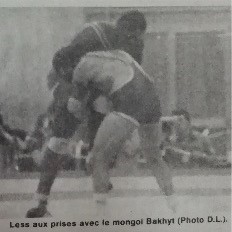
Source: Archives Nationales du Sénégal, Dakar
Figure 2: Double-Less wrestling in the 1980 Olympic Games
The success of Double-Less in the laamb stadium demonstrated the possibilities of Casamançais performance and participation in the Senegalese nation. It suggested that Casamançais could “wrestle” with the Senegalese all they wanted. But in the end, they could not leave The Senegalese Stadium. This essentially became the position of the Senegalese government in negotiations with the MFDC throughout the Casamance conflict: Casamançais could assert their unique identity, cultural hegemony, and some sort of political autonomy in the Casamance all they wanted, as long as they did not secede from Senegal. Under this regime, wrestling, like soccer, became a way of expressing and, in some cases, dissipating separatist tensions. As Ousseynou Faye (2002) explains, it was “by this place of conversion and distribution”18 of “the discharge of physical violence” that Senegalese society “de-dramatized the violence and secured it within acceptable limits” (p. 315).
I would go a step further and argue that not only did wrestling remove some of the drama from the “real” or uncontrolled political violence; it also helped forge a Senegalese nation. It brought communities together to cheer their wrestlers, as demonstrated by the regional wrestling matches held along with dances, singing, and celebrations to commemorate the annual anniversaries of Senegalese independence - the Fêtes de l’Indépendance - begun in 1961 (“Toutes les Provinces Senegalaises”, 1961; Hann, 2018, pp. 111-16). Some Casamançais accepted or even participated in this social regulation, preferring the violence of The Stadium to the violence of the battlefield. The separatists, however, rejected it and endeavored to tie their grievances to the wrestling arena. This history demonstrates that the stadium was a political space.
Struggling for the nation: social performance in the wrestling stadium
Today, a single Senegalese laamb match generates hundreds of thousands of dollars for wrestlers, promoters, advertisers, shamans, clerics, musicians, and of course, politicians. After his match with Yékini in 2012, Balla Gaye 2 was dubbed the “lord of the arena.” Balla Gaye 2 is the son of Mamadou Sakho, i.e. Double-Less. The Senegalese media have often referred to Sakho’s Casamançais origins to demonstrate his participation, like his father’s, in the Senegalese national pastime. This participation has been a source of pride not only for Balla Gaye but for many Casamançais eager to put the violence of the Casamance conflict behind them and to move ahead into a more peaceful future. Balla Gaye 2 was Mandinka (not Jola) and grew up in a suburb of Dakar, not in the Casamance. Thus, he personified the diverse experiences of Senegalese national identity. He was a Senegalese wrestler from the Casamance - not a Casamançais separatist eager for independence from Senegal.
From their marquee “combat” on April 22, 2012, Balla Gaye and Yékini each expected to take home around $300,000, in addition to the $100,000 prize expected from top-tier matches (Loomis, 2012). Wrestling prize money had come a long way since Mbehr Ndiaye, the 1937 champion of Rufisque, won the relatively large sum of 200 francs (Faye, 2002, p. 320). With half the Senegalese population living below the poverty line, many young Senegalese men have dreamt of becoming wrestling stars (Hann, 2018, various). Other recent Senegalese wrestling champions have gone by names like “Mohamed Aly,” “Tyson,” and “Bombardier,” demonstrating the sport’s historical ties to boxing as well as to Western media.19
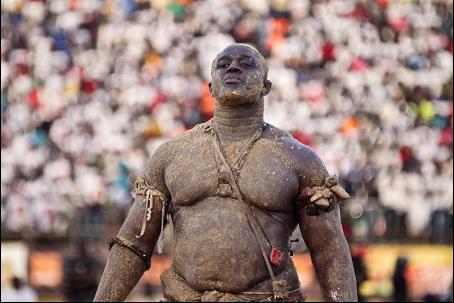
Photo by Joe Penny for The New York Times
Figure 3: Balla Gaye 2 before his championship match against Yékini, April 22, 2012
Many Senegalese believed that Balla Gaye’s strength came from his mystical power as much as his physical prowess. For hours before the wrestlers actually matched up head-to-head in the arena, they armed themselves with mystical power from songs, dances, gris-gris pouches (containing shredded verses from the Koran provided by their marabouts) tied around their limbs, and various liquids poured out over their bodies for protection from evil spirits and around the sandy wrestling ring as libations to the spirits. “The gris-gris and baths are just for protection against negative tongues and eyes,” said Mbaye Gueye Dieng, one of the Sufi marabouts attending the match (Loomis, 2012). Senegalese wrestlers believed that mystical powers from marabouts in the Casamance, The Gambia, and Guinea-Bissau had proven to be the most powerful in the ring. Thus, as a Casamançais, Balla Gaye, it was believed, enjoyed exceptional access to these powers (Faye, 2002, p. 331).20 This belief was based on a common Senegalese trope about the Casamance as pagan, animist, uncivilized, and somehow more “African” than northern Senegal.
As the political economy of wrestling in Senegal helped make the state, it also helped make the nation through the social performances in The Stadium.21 Though these contemporary social performances can be traced far back into the distant past, as demonstrated by Robert Baum (1993), they also changed with colonialism and urbanization. After 1945, political and economic entrepreneurs invested in Senegalese wrestling. Their investment benefited the state but also the nation. The combination of political, religious, ethnic, and gender identity performances in the wrestling stadium made it a particularly dynamic space for the performance of the nation. Indeed, Faye credits laamb with an important contribution to the construction of the Senegalese nation-state:
Erected as a ‘place of memory’ for the nation-state under construction, this space sheltered its operation of seduction of consumers and of ‘citizens’ that animates the different spectators of laamb. The circulation of money, of the discourses and practices between these elites and the wrestlers, emerged on the construction of a familiar society in which people know one another. The evidence of its utility was solely based on its defining satisfaction of the need to broaden the social reach of the dominant order (Faye, 2002, p. 337).
In other words, as the political economy of wrestling in Senegal helped make the state, it also helped make the nation, as it gave many different Senegalese from many different walks of life a reason to show up to The Stadium to enjoy the spectacle of la lutte - the “struggle” - together. In a way, as the wrestlers and the spectators struggled together, they made the nation.
Out in the villages and small towns of the Casamance and away from the large, commercialized wrestling arenas of Dakar, the wrestling stadium became an important space for the performance of social relations in the Casamance, as in the rest of Senegal. There have been very few stadiums as built environments for wrestling in the villages. Rather, village wrestling matches occur on a dirt field or clearing. But I am still referring to these spaces as “stadiums” where social relations play out among members of the community in ways that help form a “Casamançais” identity. Different actors have inhabited these wrestling stadiums for different purposes. The wrestlers - mostly young men - entered the stadium to prove their manhood, seeking fame and fortune. The older men entered the stadium to organize, sanction, and regulate the matches. Women entered the stadium to sing and cheer for their wrestlers, lauding their strong, lithe bodies and championship prowess. Though young girls have wrestled in the Casamance, few have continued into adulthood, as the demands of life as wives and mothers began to limit their opportunities for practice and competition. But during village matches, if not wrestling themselves, the women’s singing and dancing make them the most prominent spectators in the crowd.22
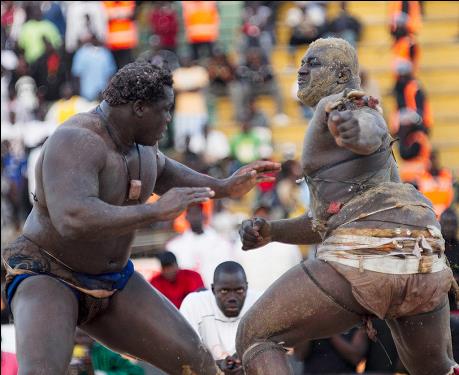
Photo by Joe Penny for The New York Times
Figure 4: On April 22, 2012, this championship match avec frappe between Balla Gaye 2 and Yekini lasted 2 minutes, 6 seconds
Thus, gender and age have comprised the most conspicuous categories of social performance in the wrestling stadium. At the village level in the Casamance, every younger man was expected to participate in the wrestling. He would bring dishonor to his family and village if he chose not to wrestle. His manhood would also be questioned (Dodou Diop, individual statement, 12 April 2014; two mid-level MFDC officials, individual statements, 1 April 2014; young Jola man, individual statement, 23 April 2014). The older men asserted their social power and control while organizing the matches and regulating the amount of acceptable violence. If tempers flared in the heat of competition, the older men quickly stepped in to limit or redirect the anger. The women cheered and sang, urging on their sons, brothers, and other favorite wrestlers to victory while literally singing their praises.23
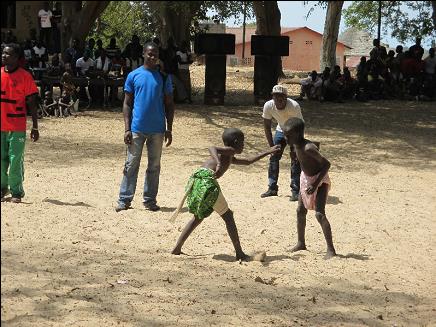
Photo by author
Figure 5: A village wrestling match between two young boys organized by older men in the village of Diembering, April 2014, for the “Festival of the Rice Field.” Spectators from all over the Lower Casamance lined the field of “combat”
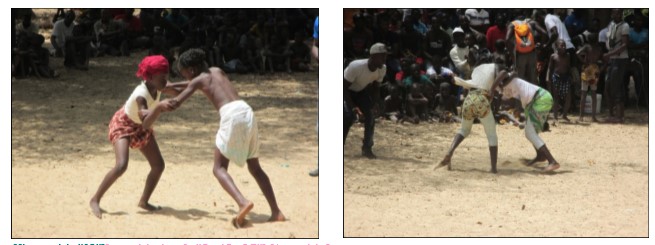
Photo by author
Figure 6: Girls also wrestled at the Festival of the Rice Field in Diembering, April 2014
Conclusion: Performing the nation in the stadium of the present
These social performances can still be seen at Senegalese wrestling matches. Wrestling fans from the Casamance - along with those from all over Senegal - participated in and performed the Senegalese nation at the same time that they cheered for Balla Gaye and proclaimed pride in their shared Casamançais identity. But at the end of the match, the struggle was over. The wrestlers, the fans, and the marabouts celebrated the victor. And then they went home. Life would go on, but they knew that soon there would be another festival or another marquee combat. It would serve as another opportunity pour vivre ensemble - to live together - as members of the Senegalese nation. As much as sport has shown the capacity to divide, it has also shown the capacity to unite. In spite of separatist attempts to map it as exclusively Casamançais, the wrestling stadium remains a vibrant, diverse space of Senegalese national imagining.














